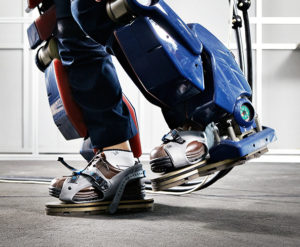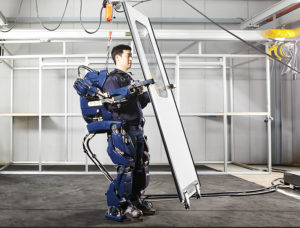It’s a Gundam! No, wait. It is the new wearable robot by the Hyundai Motor Group. Hyundai revealed its newest exoskeleton prototype on a company blog post in May 2016. This is not the first wearable robot by Hyundai. Last year they presented a walking assist device for the full spectrum of movement. The 2015 powered orthotic was controlled using Lab View by National Instruments (NI). NI used the exoskeleton as an exemplary project that greatly benefited from their software (full article can be found on NI’s website). Last year, the engineers at Hyundai had a goal of creating an exoskeleton that is less than 10kg in total weight. There were also some prototypes for a modular exoskeleton that can be assembled as needed (for example the same exoskeleton could be powered hip only, powered knee only or combined to form a powered hip-knee device).

If in 2015 the developers at Hyundai were building devices under 10kg, then it seems that someone told them to go and build an exoskeleton on the other extreme end of the spectrum. The new wearable robot presented last week seems to weigh no less than 70kg dry weight. This exoskeleton is so big, it effortlessly makes it into the top 5 largest exos ever made. Other contenders for biggest exoskeleton would be the GE Hardiman (1965-1971), MS-2 Power Loader (officially Dual-Arm Power Amplification Robot) by Panasonic – ActiveLink (2009), Sarcos’ XOS2 (2010), older versions of the Lockheed/Ekso HULC (2010), and the Italian Perceptual Robotics Laboratory (Percro) Body Extender (2011).
Look at the dates of completion of all other large and heavy exoskeletons again: 1971, 2009, x2 2010 and 2011. There hasn’t been a large exoskeleton developed since 2011! Transitioning from full body exoskeletons that try to do everything to progressively smaller and smaller specialized wearable robots is one of the most consistent trends in wearable robotics. What were the engineers at Hyundai thinking? Do they have some new technology that can usher in the return of large exos? Or perhaps they wanted to see for themselves why every single other developer has started making smaller wearable devices?

We might never know what is the real motivation behind the new Hyundai wearable robot, but just look at that plating covering the legs. This wearable robot seems to jump directly out of a giant robot anime. The large and complex covers make this one of the most visually intriguing and aesthetically pleasing exoskeletons ever developed!
Below is a rough translation of the 2016-05-11 Hyundai blog post (courtesy of Google Translate):
“The Hyundai Motor Group – Mobility of the Future Dreams, What will the world look after it makes a wearable robot?
Did you know that Hyundai Motor Group is developing the Iron Man suit?
…
Hyundai Motor Group is aiming to commercialize a wearable robot being developed and is expected to be used for multiple purposes.
First, significantly increase the productivity of workers and lower the likelihood of accidents. Particularly useful in the workplace where workers need to lift heavy objects. You should wear a wearable robot because it prevents injuries to joints like the hip and knee.
…
It can also be used for defense. Soldiers can use it to move more quickly over long distances without feeling the accoutrements of wearing 50kg weight at all. Can be used by the paraplegic handicapped, the elderly, etc. You can also take advantage of rehabilitation for the injured. As such vast availability of wearable robots, there is one thing in common:
That’s potential as a future means of transport (Next Mobility). Wearable robot development of the Hyundai Motor Group will eventually lead to the free movement of people and things. So that advances in technology could emerge as improving quality of life. The evolution of Hyundai Motor Group will continue towards the Next Mobility.”
Let’s analyze what the Hyundai blog post is saying (taking it with a grain of salt since this is not an official press release and it is loosely translated). First, Hyundai is still exploring entering into any and all of the potential exoskeleton subfields: medical, work/industry, military and civilian. Second, the company seems to feel that wearable robotics will be developed, will become a commercial success, and it might as well be them that make them. Third, and most importantly, the entire end section talks about exoskeletons as a mobility device. This does two things, it ties the company to its car manufacturing and it emphasizes that they see the biggest market potential of exoskeletons that there is.
This is the possibility that one day everyone will use exoskeletons. Going on a long hike with friends, get your exo. Taking grandma on a walk, get her exo. Going to the market? Don’t get your car, instead put on your exo and jog there and back. Standing in place for a very long time or patrolling an area, get your exo. Making exoskeletons to be as reliable and ubiquitous as a bicycle is the biggest dream in the exoskeleton industry with the largest possible market. It is no coincidence that the Hyundai blog post mentions this twice.
Additional observations on the new Hyundai wearable robot:

This exoskeleton is large and heavy, but there is no cage in front of the operator to protect from a fall. In the pictures provided, we can see the device is tethered to the ceiling and this is currently the only safe way to have an operator use it. This exoskeleton is also power hungry and needs to be connected to an electrical supply at all times (the two cables coming from the back).
Combining the need for overhead tethering, the power cable and the extremely shiny covers and plating, it is safe to say this suit will never see the light of a real factory floor. Finally, for a suit that presumably has no internal power supply, the backpack is unusually large. Having what looks like at least 14 large motors, there must be multiple controller boards that take up a lot of space and require constant cooling.

Finally, the 2015 Hyundai exoskeleton (image to the right) did not have a foot plate but transferred weight directly into the ground, similar to the FORTIS by Lockheed Martin, but the larger wearable robot presented here returns back to foot plates. Foot plates, while perfectly acceptable, have been blamed by able bodied users for causing disorientation and loss of balance because workers and soldiers can no longer feel the ground below them.
It is always exciting to see what new exoskeletons are being cooked up around the world. Special thanks to the TheVerge and ZDnet for being some of the first western outlets to cover this story and making it trend on Google News.
References:
Hyundai Motor Company Blog Post 2016-5-11 Wearable Robot
National Instruments: Hyundai Wearable Robotics for Walking Assistance Offer a Full Spectrum of Mobility








Good day, I am doing research regarding the availability of Exoskeleton for the South African market. Please let me have as much details as possible. I am quite happy to present myself to your country. Thanking you. Nad